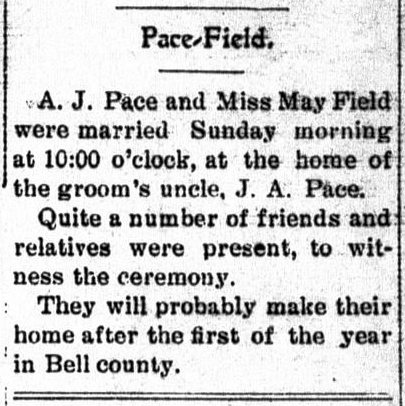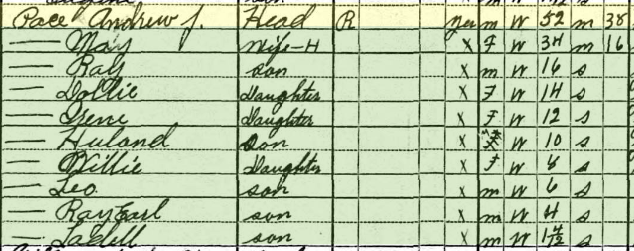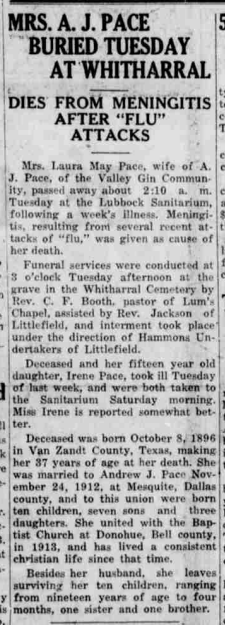My 31st entry in Amy Johnson Crow’s “52 Ancestors in 52 Weeks” family history blogging challenge for 2015.
The challenge: have one blog post each week devoted to a specific ancestor. It could be a story, a biography, a photograph, an outline of a research problem — anything that focuses on one ancestor.
I am still quite behind on the challenge due to a summer school course.
My 31st ancestor is my husband Jeff’s 2nd Great-Grandfather William Sanford “W.S.” Fields (1868-1945).
There is nothing enjoyable in telling this particular story, but it confirms information that my husband’s cousins and I have been trying to learn.
Information Baseline
In conversations I have had with my husband’s cousins, and in notes I have found on public Ancestry Member Trees, I was made aware that 2nd Great-Grandfather William Sanford Fields went to jail for rape when his youngest daughter–my husband’s Great-Grandmother Laura Mae Fields (1896-1933)–was very young. Our branches of the family never knew him and never saw him after he got out of prison, and Laura Mae’s daughter’s would not talk about the event when younger more removed generations asked about the incident.1

This is that later post.
Chronology of Events
The documentation investigated here was analyzed to answer the research question: “Was William Sanford Fields, father of Julius Fields and great-grandmother Laura Mae Fields, sent to jail for committing rape?”
The Rape
“On or about” 1 April 1897, William Sanford Fields (age 29) raped Alice Requardt, who was not yet 15 years of age. A public domain digitized law report available on Google Books provides very thorough details about the crime.4
The rape victim was newly married to husband Fritz Requardt, and the couple lived at the home of my husband’s 2nd Great-Grandparents William Sanford Fields and Dollie [?] Fields [in McLennan County, Texas]. While Dollie Fields–who I assume took their three young children with her–was away in Waco, McLennan County, Texas, caring for her sick sister, and the victim’s husband was away on business in Waco, W.S. Fields sexually assaulted Alice Requardt. The victim reported the attack to her husband when he returned. After they fled to her father’s home, her father reported the rape to authorities.5
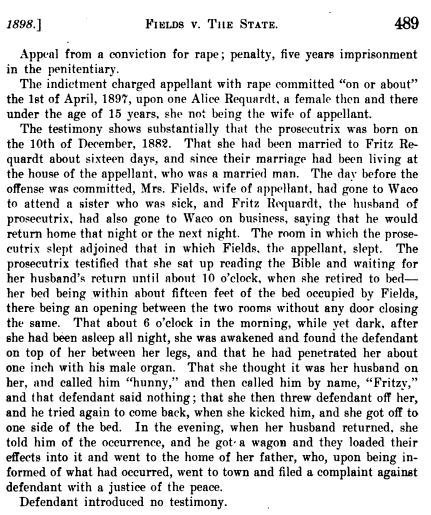
Conviction & Sentencing
On 12 January 1898, William Sanford Fields was convicted of criminal assaulted in Waco, McLennan County, Texas. He was sentenced on the same day to 5 years in the penitentiary. A brief announcement appeared that day in the Austin (Texas) Weekly Statesman.7

The Appeal
W.S. Fields appealed his sentence, with the appeal making its way up to the Texas Court of Criminal Appeals. On 25 June 1898, the appeal was overruled. The same digitized law report is actually a report on the appeal, not the original case. But it provides details about the original case, which I discussed above.
In Fields v. The State, we see 2nd Great-Grandfather W.S. Fields and his lawyers filing an appeal against the original case verdict, on a technicality. They argued that the Texas statute uses the term “carnal knowledge” in its definition of rape, yet the indictment failed to use that full term, and instead stated that the defendant “did then and there ravish and have carnal [the term “knowledge is not included here] of the said A.R.” Therefore, the charge was erroneous. But the appellate judge ruled the indictment was sufficient.9
The appeal also tried to impeach the credibility of the victim’s husband as a witness [witness of her age], claiming the witness was a bigamist still married to another woman. The appellate court ruled that no such impeachment could take place since the witness had never been indicted for bigamy.9
Doing Time
Incarceration
According to prison records, W.S. Fields was admitted to the Texas State Penitentiary in Huntsville, Walker County, Texas on 13 November 1898, with a sentence of five years. Slightly less than one year later, on 9 October 1999, he was punished for laziness.11
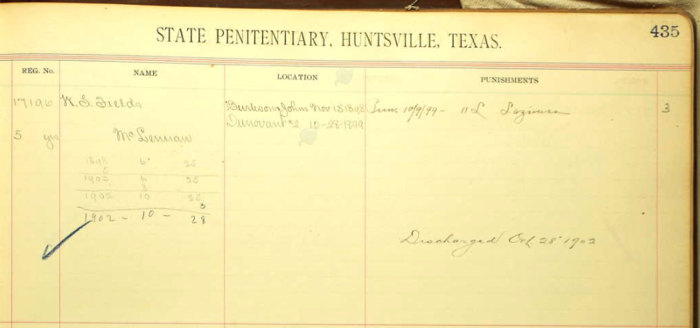
Convict Camps
The 1900 U.S. census shows W.S. Fields enumerated 2 July 1900 in Colorado County, Texas, at an institution named Convict Camp No. 2.He is described as married (for 13 years, calculating out to about an 1887 marriage date), 32 years of age (born February 1868), and working as a farm laborer.13


However Judy describes her great-grandfather’s place of work as Dunovant’s Camp No. 1.
William Dunovant was one of the biggest landowners in all of Colorado County, Texas, around the time when Jasper was a prison guard — and he hired convict labor to work on his sugar and rice plantations.”17
Same census, same county, same precinct as my W.S. Fields. Different convict camps.
So these were convict labor camps, run by private individuals. Texas operated a convict lease system from 1867 to 1912, that leased penitentiary prisoners out as labor.18
Time to take a closer look at the 1900 federal census record for my W.S. Fields, flipping back and forth to the page preceding and following his census entry. The page after the one that records Fields provides a more complete name of the institution where Fields was living and enumerated–Dunovant’s Convict Camp No. 2. Dunovant. Just like in Judy’s blog post.

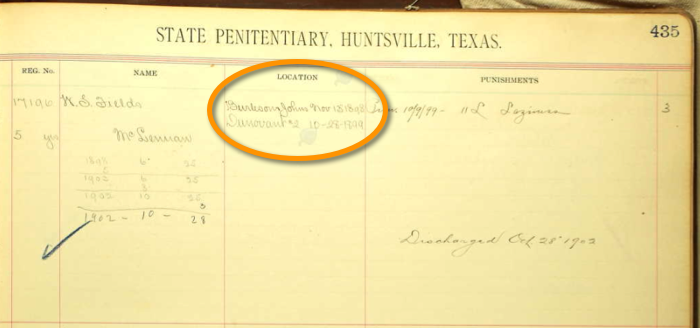
- Burleson & John’s: Dated 13 November 1898. This is likely the day he was first leased out. Burleson & John’s Farm was a convict camp located in Hill County, Texas.
- Dunovant’s: Dated 28 October 1899. This also is likely the day he was leased out to this camp. We know that he was there at least through 2 July 1900, the date he was enumerated on the federal census.
When I made the connection between my husband’s ancestor and Judy’s ancestor, I hit her up on Facebook, joking that she and my husband are now Texas Prison System Kin. Judy and I chatted more about the coincidence. She informed me that her great-grandfather “Jasper was a guard at Dunovant Camp 2 in the late spring and summer of 1899.”21 Might Judy’s great-grandfather have been a guard at the very convict labor camp where my husband’s 2nd great-grandfather was imprisoned as a farm laborer? Might Judy’s ancestor have been the one who punished William Sanford Fields for laziness, as noted on Fields’ convict register entry? Nope. Her Jasper only worked at Camp 2 until the summer of 1899. My W.S. Fields was not leased out to that same camp until October of 1899.
Released
Fields was discharged on 28 October 1902, in the penitentiary for less than his 5-year sentence, but perhaps the time spent in jail during his appeal process was counted towards his sentence.22
Impact on the Family
His youngest daughter–my husband’s Great-Grandmother Laura Mae Fields– was only 15-months-old when her father was convicted and sentenced. She was 2-years-old when her father was sent to Huntsville, and 6-years-old when he was released. I have no evidence to support that Laura Mae ever saw her father after the rape and trial.
Son Julius–who we discussed last week, when we found 13-year-old Laura Mae living with him and his new wife on the 1910 U.S. census–was thrust into the role of “man of the family” at a very young age.23 He would have only been about 6-1/2 years old when his father was convicted and sentenced, and age 7 when his father went to prison.
Going back to that 1900 federal census record for the family, we can see that the family lived in the same county in which the initial charges were filed for the April 1897 rape and the January 1898 trial was held. I cannot tell from the evidence if William Sanford’s wife and children lived still, in 1900, in the very house where the crime took place. Wife Dollie must have felt intense anger towards her husband and shame. It had to be very difficult for her to hold her head up in their community, to shield her very young children from town gossip, and to provide for her three children (remember…the 1900 census shows no one in the family as working).24
It is no wonder that Dollie chose to identify herself as a widow (her husband identifies himself as married), since she was the likely informant, on that 1900 census. I find no evidence that she and husband William Sanford ever received a divorce. Dollie apparently considered her husband dead to her and the children.
[contentblock id=63 img=html.png]
Next Steps?
The information from these records sufficiently answers my current research question. But there is still a lot more work to do on my husband’s 2nd great-grandfather William Sanford Fields.
- Begin documenting and piecing together the rest of Fields’ life story.
- Locate a possible marriage record for William Sanford Fields and wife Dollie, as I still do not have documented evidence of their marriage, and this will likely provide me with Dollie’s maiden name as well, so that I can continue researching her line.
Sources
Sorry, EE citation purists. This footnote plugin does not place nicely with more than one “Ibid” reference or with [brackets].
